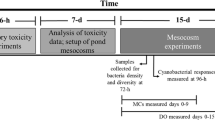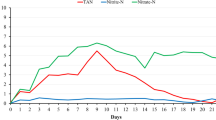Abstract
The residues of lincomycin (LIN), an antibiotic administered to aquatic animals, are often detected in aquatic environments. This study investigated effects of three environmental factors, sunlight, microbial activity, and temperature, on declines of spiked LIN in waters and sediment slurry samples collected from freshwater tilapia (Oreochromis mossambicus) and marine shrimp (Litopenaeus vannamei) culture ponds. The results showed that sunlight, temperature, and microbial activity all accelerated LIN transformation in the water and slurry samples. In matrixes of all water and slurry samples, LIN transformation was significantly faster under light conditions [half-life (t1/2) = 24–53 days] than under dark conditions (t1/2 = 154–2897 days). Microbial activity also accelerated LIN transformation; the t1/2 of LIN was shorter after nonsterile treatment (t1/2 = 12–809 days) than after sterile treatment (t1/2 = 154–2897 days). Moreover, LIN transformation was faster at 28 °C (t1/2 = 18–38 days) than at 20 and 12 °C (t1/2 = 34 and 462 days, respectively) in both slurry samples. The results revealed that LIN transformation in aquaculture pond water and sediment was either slow or stagnant. Sunlight, microbial activity, and temperature can accelerate LIN transformation to reduce LIN residue levels.



Similar content being viewed by others
References
Augugliaro V, García-López E, Loddo V, Malato-Rodríguez S, Maldonado I, Marcì G, Molinari R, Palmisano L (2005) Degradation of lincomycin in aqueous medium: coupling of solar photocatalysis and membrane separation. Sol Energy 79:402–408
Bautitz IR, Nogueira RFP (2010) Photodegradation of lincomycin and diazepam in sewage treatment plant effluent by photo-Fenton process. Catal Today 151:94–99
Botelho RG, Christofoletti CA, Correia JE, Ansoar Y, Olinda RA, Tornisielo VL (2015) Genotoxic responses of juvenile tilapia (Oreochromis niloticus) exposed to florfenicol and oxytetracycline. Chemosphere 132:206–212
Boxall ABA (2004) The environmental side effects of medication. EMBO Rep 5:1110–1116
Carabineiro SAC, Thavorn-Amornsri T, Pereira MFR, Figueiredo JL (2011) Adsorption of ciprofloxacin on surface-modified carbon materials. Water Res 45:4583–4591
Carabineiro SAC, Thavorn-amornsri T, Pereira MFR, Serp P, Figueiredo JL (2012) Comparison between activated carbon, carbon xerogel and carbon nanotubes for the adsorption of the antibiotic ciprofloxacin. Catal Today 186:29–34
Chien YH, Lai HT, Liu SM (1999) Modeling the effects of sodium chloride on degradation of chloramphenicol in aquaculture pond sediment. Sci Total Environ 239:81–87
Du J, Zhao H, Liu S, Xie H, Wang Y, Chen J (2017) Antibiotics in the coastal water of the South Yellow Sea in China: occurrence, distribution and ecological risks. Sci Total Environ 595:521–527
FAO (2016) The state of world fisheries and aquaculture 2016, contributing to food security and nutrition for all. FAO, Rome, p 204
Guo J, Selby K, Boxall ABA (2016) Assessment of the risks of mixtures of major use veterinary antibiotics in European surface waters. Environ Sci Technol 50:8282–8289
Han X, Peng Y (2016) Light-scattering characteristics of hydrated ions in dilute solutions of major sea salts. Optik 127:1455–1459
He Z, Cheng X, Kyzas GZ, Fu J (2016) Pharmaceuticals pollution of aquaculture and its management in China. J Mol Liq 223:781–789
Heuer OE, Kruse H, Grave K, Collignon P, Karunasagar I, Angulo FJ (2009) Human health consequences of use of antimicrobial agents in aquaculture. Clin Infect Dis 49:1248–1253
Huang DJ, Hou JH, Kuo TF, Lai HT (2014) Toxicity of the veterinary sulfonamide antibiotic sulfamonomethoxine to five aquatic organisms. Environ Toxicol Pharmacol 38:874–880
Kim K-R, Owens G, Kwon S-I, So K-H, Lee D-B, Ok Y (2011) Occurrence and environmental fate of veterinary antibiotics in the terrestrial environment. Water Air Soil Pollut 214:163–174
Kumar P, Jetani K, Yusuzai S, Sayani A, Dar SA, Rather MA (2012) Effect of sediment and water quality parameters on the productivity of coastal shrimp farm. Adv Appl Sci Res 3:2033–2041
Kümmerer K (2009) Antibiotics in the aquatic environment—a review—part I. Chemosphere 75:417–434
Lai HT, Hou JH (2008) Light and microbial effects on the transformation of four sulfonamides in eel pond water and sediment. Aquaculture 283:50–55
Lai HT, Hou JH, Su CI, Chen CL (2009) Effects of chloramphenicol, florfenicol, and thiamphenicol on growth of algae Chlorella pyrenoidosa, Isochrysis galbana, and Tetraselmis chui. Ecotoxicol Environ Saf 72:329–334
Lai HT, Lin JJ (2009) Degradation of oxolinic acid and flumequine in aquaculture pond waters and sediments. Chemosphere 75:462–468
Lai HT, Liu SM, Chien YH (1995) Transformation of chloramphenicol and oxytetracycline in aquaculture pond sediments. J Environ Sci Health A30(9):1897–1923
Lai HT, Lin JS, Chien YH (2011a) Effects of light regime and oxygen profile on transformation of oxolinic acid in pond sediment. Bioresour Technol 102:5425–5430
Lai HT, Wang TS, Chou CC (2011b) Implication of light sources and microbial activities on degradation of sulfonamides in water and sediment from a marine shrimp pond. Bioresour Technol 102:5017–5023
Lai WW-P, Lin Y-C, Wang Y-H, Guo YL, Lin AY-C (2018) Occurrence of emerging contaminants in aquaculture waters: cross-contamination between aquaculture systems and surrounding waters. Water Air Soil Pollut 229:249
Liao X, Li B, Zou R, Xie S, Yuan B (2016) Antibiotic sulfanilamide biodegradation by acclimated microbial populations. Appl Microbiol Biotechnol 100:2439–2447
Lin JS, Pan HY, Liu SM, Lai HT (2010) Effects of light and microbial activity on the degradation of two fluoroquinolone antibiotics in pond water and sediment. J Environ Sci Health B 45:456–465
Lin AY-C, Tsai Y-T, Yu T-H, Wang X-H, Lin C-F (2011) Occurrence and fate of pharmaceuticals and personal care products in Taiwan's aquatic environment. Desalin Water Treat 32:57–64
Lin AY-C, Yu T-H, Lin C-F (2008) Pharmaceutical contamination in residential, industrial, and agricultural waste streams: risk to aqueous environments in Taiwan. Chemosphere 74:131–141
Liu X, Steele JC, Meng X-Z (2017) Usage, residue, and human health risk of antibiotics in Chinese aquaculture: a review. Environ Pollut 223:161–169
Nikolaou A, Meric S, Fatta D (2007) Occurrence patterns of pharmaceuticals in water and wastewater environments. Anal Bioanal Chem 387:1225–1234
Pan M, Chu LM (2017) Fate of antibiotics in soil and their uptake by edible crops. Sci Total Environ 599-600:500–512
Paola AD, Addamo M, Augugliaro V, García-López E, Loddo V, Marcì G, Palmisano L (2006) Photodegradation of lincomycin in aqueous solution. Int J Photoenergy 2006:1–6
Picó Y, Andreu V (2007) Fluoroquinolones in soil—risks and challenges. Anal Bioanal Chem V387:1287–1299
Stentiford GD, Neil DM, Peeler EJ, Shields JD, Small HJ, Flegel TW, Vlak JM, Jones B, Morado F, Moss S, Lotz J, Bartholomay L, Behringer DC, Hauton C, Lightner DV (2012) Disease will limit future food supply from the global crustacean fishery and aquaculture sectors. J Invertebr Pathol 110:141–157
Sui Q, Zhao W, Cao X, Lu S, Qiu Z, Gu X, Yu G (2017) Pharmaceuticals and personal care products in the leachates from a typical landfill reservoir of municipal solid waste in shanghai, China: occurrence and removal by a full-scale membrane bioreactor. J Hazard Mater 323(Part A):99–108
Szúnyog J, Adams E, Liekens K, Roets E, Hoogmartens J (2002) Analysis of a formulation containing lincomycin and spectinomycin by liquid chromatography with pulsed electrochemical detection. J Pharm Biomed 29:213–220
Turiel E, Martín-Esteban A, Bordin G, Rodríguez AR (2004) Stability of fluoroquinolone antibiotics in river water samples and in octadecyl silica solid-phase extraction cartridges. Anal Bioanal Chem 380:123–128
Van Boeckel TP, Gandra S, Ashok A, Caudron Q, Grenfell BT, Levin SA, Laxminarayan R (2014) Global antibiotic consumption 2000 to 2010: an analysis of national pharmaceutical sales data. Lancet Infect Dis 14:742–750
Yu WH, Chin TS, Lai HT (2013) Detection of nitrofurans and their metabolites in pond water and sediments by liquid chromatography (LC)-photodiode array detection and LC-ion spray tandem mass spectrometry. Int Biodeterior Biodegrad 85:517–526
Zhang Y, Wang X, Yin X, Shi M, Dahlgren RA, Wang H (2016) Toxicity assessment of combined fluoroquinolone and tetracycline exposure in zebrafish (Danio rerio). Environ Toxicol 31:736–750
Funding
This study was supported by the Ministry of Science and Technology, Taiwan [grant numbers MOST 105-2313-B-415-005, MOST 106-2313-B-415-009].
Author information
Authors and Affiliations
Corresponding author
Additional information
Responsible editor: Ester Heath
Rights and permissions
About this article
Cite this article
Lei, KH., Lai, HT. Effects of sunlight, microbial activity, and temperature on the declines of antibiotic lincomycin in freshwater and saline aquaculture pond waters and sediments. Environ Sci Pollut Res 26, 33988–33994 (2019). https://doi.org/10.1007/s11356-018-3006-y
Received:
Accepted:
Published:
Issue Date:
DOI: https://doi.org/10.1007/s11356-018-3006-y




